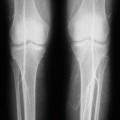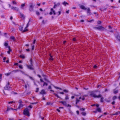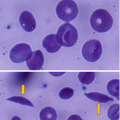(1)
Department of Surgery, Dar A lAlafia Medical Company, Qatif, Saudi Arabia
20.1 Introduction
Sickle cell anemia is an inherited hemoglobinopathy that causes acute and chronic hemolytic anemia.
Patients with sickle cell anemia have a variable Hb level that may range from 7.0 to 11.0 g/dL in their steady-state condition.
This however may decrease as a result of several sickle cell anemia-related complications.
Blood transfusion should be aimed to increase tissue delivery of oxygen.
Blood transfusion however is not totally safe and short- or long-term complications may occur.
In patients with SCA, blood transfusion has several advantages:
Raises the hemoglobin level for oxygen delivery
Lowers the percentage of sickle Hgb (HgbS)
Decreases the propensity for vaso-occlusion
Suppression of erythropoietin release caused by the rise in Hgb, thereby reducing the production of new HgbS-containing cells
Increases in Hgb oxygen saturation levels by approximately 1–6 %, which increases oxygen delivery to the tissues
The indications of blood transfusion in patients with sickle cell anemia are variable and include acute hemolytic, aplastic, or sequestration crises.
Chronic blood transfusion is indicated in cases of strokes or high cerebral blood flow on skull Doppler ultrasonic studies, recurrent acute chest syndrome, and recurrent splenic sequestration crisis.
Exchange blood transfusion is indicated in severe acute chest syndrome (ACS), priapism, or perioperatively.
Once it is decided to transfuse blood, the transfused blood should be Hb S negative and Rh and Kell antigen matched.
Used correctly, blood transfusion can be life-saving and prevent progressive organ damage in patients with sickle cell anemia.
In patients with sickle cell anemia, blood transfusions are indicated for either episodic events triggered by an acute complication or in the form of chronic blood transfusion therapy.
Several methods of transfusion are available, including simple blood transfusion, partial exchange transfusion, or erythrocytapheresis.
The method used depends on the specific indications.
Fresh blood (less than 3 days old) should be used in exchange transfusions done to improve oxygen delivery because of hypoxia.
Patients with a history of alloimmunization should be given as few transfusions as possible and phenotypically matched units if practical.
These patients must carry a record of all documented alloantibodies and show it to any physician contemplating giving them blood transfusion.
Patients with a history of febrile transfusion reactions should be given leukocyte-depleted units and may be pretreated with acetaminophen and antihistamines if necessary.
Hyperviscosity from simple transfusion is a dangerous complication in patients with sickle cell anemia and must be avoided. The posttransfusion hematocrit should not exceed 36 %.
In general, limited phenotypically matched, sickle-negative, leukocyte-depleted packed cells are the blood product of choice to be transfused to patients with sickle cell anemia.
A comprehensive transfusion protocol should be established for each patient receiving blood transfusion that includes:
Accurate medical records
The patient’s red cell phenotype
Alloimmunization history
The number of units of blood received
Serial hemoglobin S percentages
Results of acquired infections
Iron overload monitoring results
There are a number of important complications that may occur with transfusion. These include:
Volume overload
Alloimmunization
Iron overload
Exposure to infectious agents
Identification bracelets should provide information regarding alloantibodies, and the number of blood transfusions is important in sensitized patients.
Screening for alloantibodies 6–8 weeks after transfusion will document new antibodies that may disappear if there is a prolonged interval without transfusion but still cause delayed transfusion reactions if further transfusions are required.
20.2 Indications for Blood Transfusion
The two primary goals of blood transfusion are:
To correct the low oxygen-carrying capacity caused by severe anemia
To improve microvascular perfusion by decreasing the proportion of sickle red cells in the circulation
The indications for blood transfusion therapy for patients with SCA are divided into two major attacks:
Therapeutic
Prophylactic/preventive
20.3 Indications for Episodic Blood Transfusion
Management of severe anemia
In severely anemic patients, simple blood transfusions should be used.
Packed red blood cell transfusion should be used to avoid volume overload.
Patients should be transfused if there is evidence of physiologic derangement, such as heart failure, dyspnea, hypotension, or marked fatigue. Their symptoms may include tachycardia, postural hypotension, dizziness, mental status change, dyspnea, or congestive heart failure.
Hemoglobin values of less than 5 g/dL or a 20 % fall below the baseline during an acute illness is indications for blood transfusion.
Acute splenic sequestration crisis:
Major acute splenic sequestration crisis produces hypovolemia and cardiovascular decompensation as a result of pooling of blood into the splenic sinusoids.
These patients require immediate blood transfusion to prevent cardiovascular collapse.
In general, blood transfusions are indicated when the hemoglobin drops by more than 2 g/dL from the steady state.
The rise in hemoglobin following blood transfusion is usually greater than expected as a result of release of sequestered red cells from the spleen.
Transient red cell aplasia (aplastic crisis):
Parvovirus B19 is the primary cause of transient red cell aplasia.
Severe anemia develops over a few days secondary to shortened red cell survival without compensatory production of new red cells.
While many patients recover spontaneously, red cell transfusions are indicated for those who become symptomatic or whose hemoglobin value falls 2 g/dL below baseline.
Hyperhemolysis:
This is associated with infection, acute chest syndrome, and particularly malaria.
Acute chest syndrome, stroke, sepsis, and acute multi-organ failure are leading causes of death in sickle cell disease.
A falling hemoglobin value often accompanies these events.
Transfusions to improve tissue oxygenation and perfusion are indicated in these seriously ill patients.
Acute chest syndrome:
When acute chest syndrome is associated with hypoxia and a falling hemoglobin, transfusions are indicated.
Early transfusion may prevent the progression of acute chest syndrome.
Many patients with acute chest syndrome can be treated with a simple red cell transfusion.
In severe cases of acute chest syndrome, exchange blood transfusion/red cell pheresis is recommended.
Stroke:
Chronic transfusion therapy reduces the rate of recurrent vaso-occlusive stroke.
The efficacy of transfusion in the management of acute stroke has not been well studied, but early exchange transfusions may improve perfusion and oxygenation to brain tissue.
Management of multi-organ failure:
Acute multi-organ failure is a devastating complication of sickle cell anemia.
This is usually associated with falling hemoglobin and platelet count, as well as progressive multi-organ failure.
Aggressive blood transfusion may improve survival and recovery of organ function.
Preparation for general anesthesia:
Individuals with SCA have a high frequency of serious perioperative complications, some of which may be ameliorated by preoperative RBC transfusion.
All sickle cell anemia patients undergoing major surgery should be prepared in advance with simple blood transfusion to correct their anemia to a hemoglobin of approximately 10 g/dL and hemoglobin S percent to approximately 60 %. This simple blood transfusion uses packed RBCs.
Indications for preoperative blood transfusion:
Preoperative transfusion is the standard of care in children and adults with sickle cell anemia undergoing major surgery.
Preoperative transfusion may not be necessary in children and adults undergoing elective, minor, low-risk surgery.
Regardless of blood transfusion or type of surgical procedure, attention to the following is necessary to minimize surgical risks:
Preoperative hydration
Incentive spirometry
Optimal management of reactive airway or other underlying chronic lung disease
Maintenance of oxygenation during postoperative sedation
Avoiding hypoxia, hypothermia, hypercarbia, and acidosis
Adequate analgesia
Early mobilization
Patients undergoing high-risk surgery (cardiovascular, ophthalmic, vascular, or brain surgery) are given preoperative exchange blood transfusion with the aim of lowering HgbS concentration of <30 %.
The optimal preoperative transfusion for children and adults with HbSS who are scheduled to undergo major surgery is to give simple blood transfusion to increase the Hgb to 10 g/dL, rather than an aggressive exchange transfusion regimen to reduce the HgbS concentration in the perioperative period.
Compared with an aggressive regimen, a conservative approach provides equivalent outcomes, similar rates of major complications, and fewer transfusion-related complications. The aggressive blood transfusion was, however, associated with increased risk of alloimmunization.
Minor surgery not requiring prolonged general anesthesia is not an indication for blood transfusion.
Acute chest syndrome:
Transfusion is an important component of the management of acute chest syndrome (ACS), which is one of the most common causes of mortality in patients with SCA.
The use of simple versus exchange blood transfusion depends on:
The severity and rate of clinical decline in pulmonary function
The corresponding increased need for respiratory support
In general, exchange blood transfusion rather than simple blood transfusion is required for those with more severe decline in respiratory function (e.g., rapid increase in oxygen requirement or work of breathing over the course of hours, along with abnormalities on chest radiography and declining oxygen saturation).
Transfusion can also be used as an adjunct to other measures (e.g., control of asthma, which is the greatest risk factor for ACS) to prevent ACS.
Blood transfusions are advocated for patients who continue to have episodes of ACS despite hydroxyurea therapy.
For children, prophylactic, regularly scheduled blood transfusions should be given if there are repeated episodes of severe acute chest syndrome despite hydroxyurea therapy and optimal management of asthma.
Short-term therapy (e.g., less than 6 months) is often used during high-risk periods, such as winter months, with increased frequency of respiratory illness, or during transition to hydroxyurea therapy.
Long-term therapy (greater than 6 months) is used for children with year-round severe ACS episodes.
Prophylactic, regularly scheduled blood transfusions are given if there have been two or more episodes of moderate to very severe ACS in the past 24 months despite maximal hydroxyurea therapy.
Exchange blood transfusions either manually or by automated apheresis is given every 4–6 weeks to maintain a maximum HgbS percentage <30 %.
Chronic transfusion therapy is continued for 1–2 years. Thereafter, the decision to continue transfusion therapy is based on a reexamination of the risk-to-benefit ratio accounting for factors such as iron overload, alloimmunization, and recent clinical course.
Definite Indications for Blood Transfusion
Acute neurologic event (stroke)
Acute splenic sequestration
Severe pneumonia or pulmonary infarction (acute chest syndrome)
Severe anemia with cardiac decompensation
Acute arterial hypoxia
Aplastic crisis with severe anemia
Hyperhemolytic crisis
Preoperative preparation for major surgery including ophthalmological surgery, cardiac surgery, and neurosurgery
Multi-organ failure
20.4 Chronic Blood Transfusion Therapy
Chronic blood transfusion therapy programs are indicated for several conditions in patients with sickle cell anemia.
The goal is to maintain the hemoglobin S at 30–50 %, depending on the specific indication.
Blood transfusions are usually given every 3–4 weeks.
Simple blood transfusions can be used.
Red cell pheresis-exchange transfusions are recommended to decrease iron overload.
Primary stroke prevention:
Chronic blood transfusion therapy reduces the occurrence of first stroke in children with a rate of high blood flow through the circle of Willis cerebral arteries, as measured by Doppler ultrasonography.
Prevention of recurrence of stroke:
Stroke is a leading cause of death in SCA, and stroke prevention is one of the major goals of comprehensive care for individuals with SCA.
The approaches to primary stroke prevention include:
Screening by transcranial Doppler
Prophylactic regularly scheduled transfusion for those with abnormal flow velocity
Secondary stroke prevention:
Chronic exchange blood transfusion, with a goal of reducing the maximum fraction of HgbS to <30 % of total Hgb and maintaining the total Hgb >9 g/dL
Chronic blood transfusion therapy for children who suffer vaso-occlusive stroke decreases the recurrent stroke rate from 90 % to less than 10 %.
Initially, the hemoglobin S level is maintained at 30 % or less for approximately 5 years.
Pulmonary hypertension and chronic lung disease:
Chronic blood transfusion therapy has been used to decrease the recurrence of acute chest syndrome.
Patients with proven pulmonary hypertension and chronic lung disease should receive long-term chronic blood transfusion therapy.
Vital organ failure:
Transfusion therapy for patients with chronic heart failure, along with interventions to improve cardiac function, enhances quality of life.
Severe anemia, secondary to chronic renal failure, often becomes debilitating, necessitating chronic blood transfusion.
Chronic debilitating pain:
A small percentage of patients with sickle cell anemia suffer from unusually protracted and severe pain episodes.
These patients have a very poor quality of life and are unable to carry ordinary daily activities.
Chronic blood transfusions are beneficial in these patients.
Children generally respond better to chronic transfusions than adults do.
20.5 Controversial Indication for Blood Transfusions
Acute priapism:
In priapism, the initial management is conservative, but if this fails, blood transfusions should be considered.
Exchange blood transfusions have been advocated for the management of acute priapism not responding to conservative management.
It is well known that recurrent priapism often produces impotence.
Chronic blood transfusion therapy is advocated for those with recurrent priapism in an effort to prevent impotence.
The aim is to maintain hemoglobin S below 30 % for 6–12 months.
Pregnancy:
In the past, blood transfusion therapy was recommended for sickle cell patients because of poor pregnancy outcome.
With improved prenatal care, the benefit of blood transfusion therapy is questionable.
Currently, blood transfusion therapy is advocated for women who experience frequent complications during pregnancy.
Management of “silent” cerebral infarct and/or neurocognitive damage:
Subclinical infarcts detected by magnetic resonance technology are often associated with neurocognitive defects.
These patients appear to be at higher risk of future stroke.
Routine chronic transfusion therapy may prove beneficial in these patients by decreasing the risk of subsequent stroke.
Leg ulcers:
These ulcers are difficult to treat in patients with sickle cell anemia.
Blood transfusions should be considered in those with recurrent skin ulcers or poorly healing ulcers after failure of conservative therapy.
Relative Indications for Blood Transfusion
Symptomatic anemia
Hepatic sequestration
Leg ulcers refractory to conservative treatment
Stay updated, free articles. Join our Telegram channel

Full access? Get Clinical Tree







